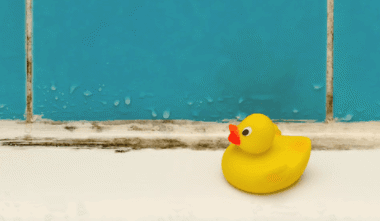Bleach may seem like the perfect solution when you find mold in your bathroom, but you will want to reconsider using it when you find out it’s not as perfect as it seems to be. Chlorine bleach is a biocide substance that should be used to destroy living organisms; however, the U.S. Environmental Protection Agency says that using a biocide is not recommended for mold cleanup because bleach doesn’t kill the mold entirely. Mold spores have roots and because of bleach’s chemical structure, it stops chlorine from getting down to the roots of the mold. While mold might remove the color from bleach, it doesn’t remove the mold.
What is recommended for killing mold?
Most households already have a solution for preventing mold – vinegar. Straight vinegar can kill approximately 82% of mold spores and can prevent future mold growth if you spray it on and let it dry (instead of rinsing it off). If the smell of vinegar bothers you, try mixing it will essential oils like grapefruit extract. (If you do use essential oils, make sure they are safe for pets to be around. For example, tea tree oil is known to be toxic to dogs.)
Is there anything guaranteed to remove mold?
If you find extensive mold in your bathroom, it is best to leave it to the professionals. Mold remediation experts remove all mold from every surface where it exists and clean up mold contamination, which could mean building materials and furnishings. Most mold remediation experts use HEPA (High-Efficiency Particulate Air) vacuums to remove mold after the area has been dried and any contaminated materials have been removed. Any materials that aren’t salvageable will be removed from the home and double bagged to prevent any contamination.
How can I prevent mold growth in my home?
There are several things you can do to help prevent mold from growing in your home, especially your bathroom.
- Make sure to inspect your toilet for leaks regularly by looking for wet areas on and around the toilet and the water line that connects the toilet to the wall.
- Test for a water leak with food coloring by adding a few drops of it to the toilet tank. After letting it sit for about 30 minutes you can check the toilet bowl and see if the water has changed color. If it has, you have a leak.
- Your toilet is only meant for flushing bodily waste and toilet paper, so don’t use it as a garbage can by flushing paper towels, feminine products, or cleaning wipes down it.
- Check the water valve shut-off. If you can’t turn it easily or it won’t budge at all, it may have gone bad and need to be replaced.
Always remember, our highly skilled plumbers are here to help you whenever you need us! If you notice mold growth in your bathroom, contact a mold remediation expert right away.
For all of your plumbing needs, contact Five Star.

